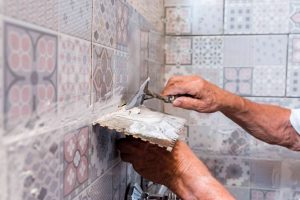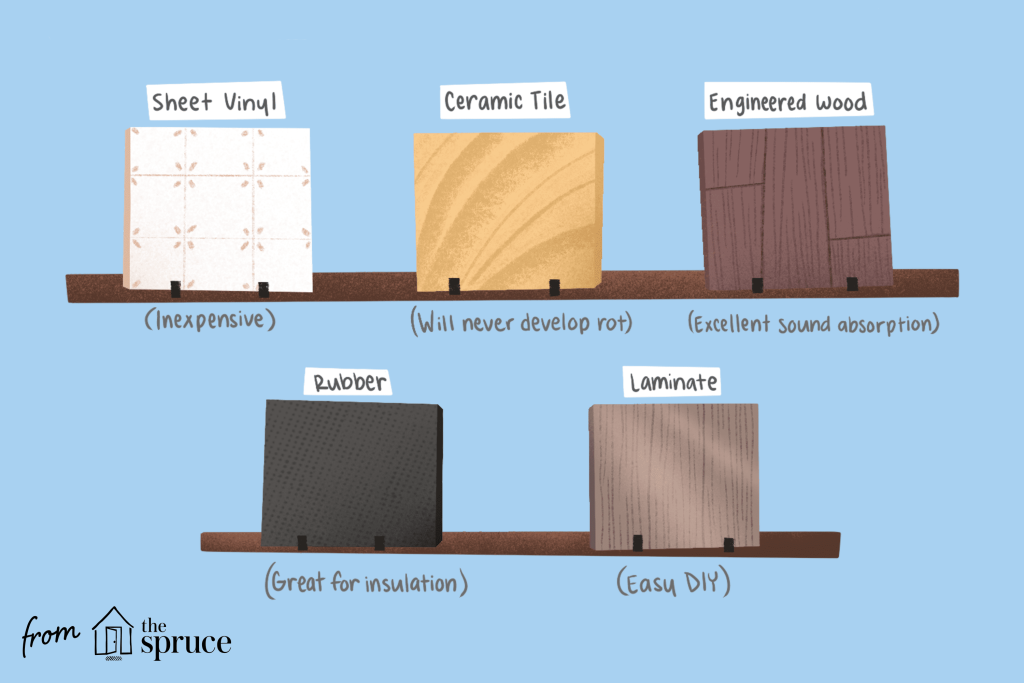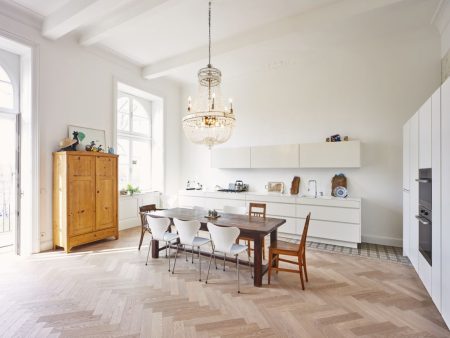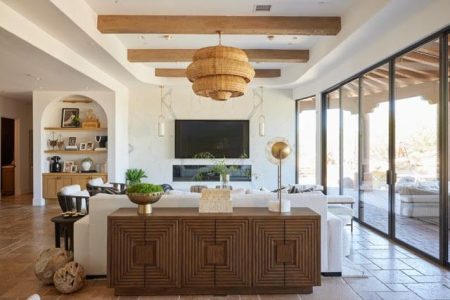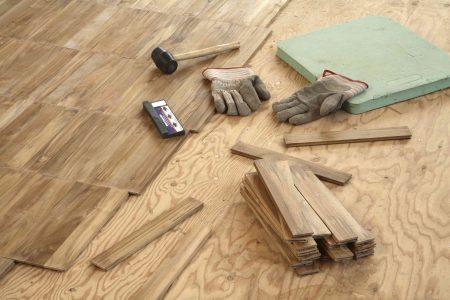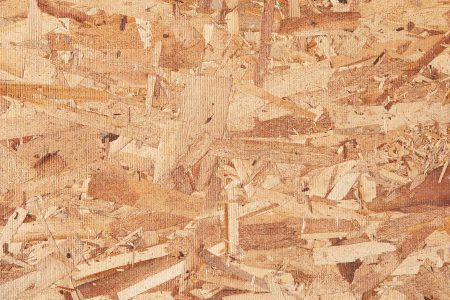Basement flooring does not play by the normal rules of flooring. Even when the weather is dry, basement flooring might leach residual moisture in the form of vapor due to its close proximity to the ground. And there are other ways that water can enter your basement. In heavy rains, basements can experience the up-to-your-ankles flooding that no one wants to see in their home.
So, along with appearance and comfort, an important concern with basement flooring is moisture: how to avoid it and how well the floor will dry out if it does become wet.
5 Qualities of Good Basement (Below-Grade) Flooring Systems
All basements are below-grade. Below-grade flooring does not refer to cheap, sub-standard flooring. Commonly used by contractors and builders, the word grade is another term for ground-level. Flooring above grade is safer from water vapor migration. Above-grade flooring is safe, too, from most normal instances of flooding. Everything at or below grade is at risk of water vapor damage, groundwater intrusion, and flooding.
- Hard Material: Hard materials like tile and concrete tend to outperform soft materials like carpets in basements. If the basement is dry enough, though, soft materials can work.
- Inorganic Materials: Organic materials like woolen carpeting will both grow mold and will begin to rot away when subjected to water over time. Inorganic materials work better in basements than organic materials. Tile, concrete, and vinyl are all inorganic materials. Solid hardwood, even though it is a hard material, does not work well in basements because it is a 100-percent organic material. Inorganic materials may grow mold, but they will not deteriorate.
- Fewer Layers: Monolithic, single-layer floors are easier to dry out than multi-layered floor systems. A classic example of a monolithic floor is concrete. Not only does it have the advantage of being hard and inorganic, but it also does not have multiple layers which can trap water.
- Raised Subfloor: Some below-grade flooring requires a raised subfloor. This can be in the form of a subfloor system or a traditional sleeper system built from scratch out of plywood and two-by-fours. Carpeting benefits from a raised subfloor. Laminate floor’s performance will be enhanced by installing it on a subfloor system.
- De-moisturizing Solutions: Water and basements is a reality for many homeowners. But moisture can be kept in check with dehumidifiers.
6 Mistakes to Avoid When Picking Out Basement Flooring
Sheet Vinyl Flooring
Vinyl flooring, also known as resilient flooring, ranks with concrete and ceramic tile as one of the better basement flooring options. Vinyl flooring comes in both sheet or tile/plank form, and there is a subtle difference.
Sheet vinyl flooring creates a nearly seamless, water-impervious surface on your basement floor, which is always a good thing where moisture might be involved. Tile vinyl flooring has multiple seams that may invite moisture infiltration if water is left standing long enough.
Pros
- Keeps water at bay
- Inexpensive, often pennies per square foot
- Warmer to the touch than ceramic tile or concrete
Cons
- Often considered a cheap fix
- Needs a very clean surface for adhesion
- Sheet vinyl installation is not usually a do-it-yourself project
- Can be difficult to remove if adhesive was used to attach the vinyl floor
Ceramic or Porcelain Tile Flooring
Of all the basement flooring options, tile represents the best of many worlds. It qualifies as a finished surface, meaning that it is not a raw surface, like concrete. Yet this is a finished surface that is attractive on its own; it needs no additional treatment as concrete does.
Ceramic or porcelain tile can be installed directly on your concrete slab. Because tile on concrete can be cold, radiant heating can be sandwiched between the concrete and the tile to warm the tile surface.
Though ceramic tile can be installed directly on the concrete slab, it’s usually best to first install an uncoupling membrane. The membrane lets the concrete slab move and crack independently of the upper tile floor. It won’t buffer the tile from all cracks, though. A crack that’s sizable enough will pass through the membrane and will affect the tile.
Pros
- Dries out and is undamaged in the event of flooding
- Laying tile in small areas can be a do-it-yourself project
- Will never develop rot
Cons
- Requires the addition of radiant heating if temperature is an issue
- Poor sound absorption qualities
- Installing large areas of tile can be a daunting task for do-it-yourselfers and may require professional work
- Very difficult to remove and replace, if there is ever a need
- A concrete slab may need significant leveling and repair, because there will be no intervening subfloor to compensate for slab problems
Engineered Wood Flooring
Since wood is derived from trees and is organic, it does not stand up well to prolonged moisture. Thus, solid hardwood is one of the worst basement flooring options. But engineered wood flooring is a different story. Engineered wood flooring is considered to be dimensionally-stable, as its cross-hatched plywood base below the real wood veneer maintains its shape when subjected to limited amounts of moisture.
Pros
- Holds up well to mild amounts of moisture
- One of the more attractive basement flooring options
- Excellent sound absorption qualities
Cons
- Must be installed on some type of subfloor
- One of the more expensive basement flooring options
- More difficult to take up in the event of water damage, since it is nailed or stapled to the subfloor
Luxury Vinyl Plank or Tile
Luxury vinyl flooring is a more recent category of resilient flooring than the conventional type that is joined by adhesive to the subfloor. Instead, luxury vinyl is joined piece-to-piece in floating floor fashion. Another major difference is that luxury vinyl flooring can look remarkably similar to the material it is replicating, whether wood or stone.
Wood-look luxury vinyl comes in planks around six inches by 48 inches. Because it is relatively thick, it can be deeply embossed for a texture that more closely resembles real wood grain. Stone-look luxury vinyl tile aims to replicate the look of slate, travertine, marble, and other popular stones, yet in the form of a vinyl tile. Stone-look luxury vinyl comes in square shapes sized 16-inch by 16-inch or smaller.
Pros
- Thick wear layer means greater durability than found in conventional sheet or tile vinyl flooring
- Overall thickness up to twice as thick as conventional tile or sheet flooring means a slightly warmer floor
- Many wood species and stones can look amazingly like the real thing
- Easy to remove since it is a floating floor (unattached to the subfloor)
Cons
- Luxury tile may not result in a better resale value since some home buyers may consider vinyl tile an inferior material
- As a seamed floor covering, luxury vinyl plank and tile may leak moisture down to the subfloor in the event of flooding
- Higher cost for a product that is still essentially a vinyl tile
Concrete Flooring
With changing attitudes toward utilitarian surfaces, concrete has come into wider acceptance by homeowners. Concrete does not have to remain in its raw state. It can be painted or stained to give it a different appearance. In fact, if extensive patching is needed, then painting is the only way to cover up the patches.
Pros
- The most moisture-hardy basement flooring option around
- Requires the least amount of materials
- Does not require a sub-floor
Cons
- Coldest of all basement flooring options, with no way to heat it from below
- Poor sound quality, a huge deficit if you wish to install a home cinema in your basement
- Requires more labor than one might imagine because concrete must be intensively scoured and cleaned before it can be painted
Plank Tile Flooring
Plank-sized porcelain tile flooring is impervious to moisture and, with its sharply rendered graphics, looks surprisingly like real wood. It is popular and well-regarded as a highly durable surface.
Plank tile flooring is so durable that it is increasingly being installed in high-traffic areas like restaurants and other commercial spaces. The chief difference between plank tile and conventional tile is that plank’s edges are rectified. These 90-degree edges mean that tiles are fitted edge-to-edge, with no mortared grout lines.
Pros
- Increasingly considered a status item, thus gaining a higher resale value
- Attractive aesthetics
- Waterproof
- Rectified edges mean smaller grout lines
Cons
- Usually more expensive than conventionally sized tile
- Because it is still ceramic tile, it feels cold underfoot unless you install radiant heating mats
- Difficult to remove
Wall-to-Wall Carpeting
Wall-to-wall carpeting is often vilified as a poor flooring material in bathrooms. Carpeting dries slowly and can develop mold and mildew. When wet, it feels mushy and uncomfortable. But does this mean that carpet is also a bad basement flooring option?
With the exception of extreme circumstances like flooding, basements generally have less moisture than even your average bathroom. And with the installation of a solid subfloor system, wall-to-wall carpeting in basements can be made to work.
Carpeting in basements should be installed in a case-by-case manner. If your basement is completely dry all throughout the year, it may give you up to a decade of reliable service. But be prepared for having to replace the entire carpet in the event of a water-based catastrophe, like flooding from the exterior, a broken pipe, or a malfunctioning water heater.
One creative alternative to wall-to-wall carpeting is to install carpet squares. Unlike the super low-pile indoor-outdoor squares that have been carpeting basements for decades, newer carpet squares are thicker and more attractive. In the event of flooding, carpet squares will get just as soaked and ruined as wall-to-wall carpet. But you can selectively pull up and replace carpet squares. It’s more difficult to excise and replace portions of wall-to-wall carpeting.
Pros
- One of the warmest basement flooring options, even without installation of radiant heating
- Improves sound quality for home theaters
- A great option if you have small children who play on the floor
- Easy to remove if it does become damaged with water
Cons
- Fairly expensive, especially if you opt for thicker piles and padding
- Though carpet can dry, it often takes industrial-quality drying equipment or services to get the job done fast enough before mold develops.
Laminate Flooring
Laminate flooring is more attractive than ever before, due to improved image layer graphics and thicker surfaces for deeper embossing. But underneath, it is still susceptible to moisture problems. When laminate’s base material comes into prolonged contact with water, it will swell up and stay that way permanently. No amount of drying will cause the laminate to return to its previous size. In addition, the top image and wear layers will begin to peel off. The only way to fix water-damaged laminate flooring is to completely replace it.
Conventional laminate flooring in the basement can be made to work with the installation of a proper subfloor system. The subfloor and the laminate’s foam underlayment protect against water vapor coming up from the concrete slab. Also, in the event of very minor flooding, the subfloor system will elevate the laminate flooring above the water.
Waterproof laminate has no wood content, so it will not swell and distend. However, it is still a product in search of a buying audience. It is difficult to obtain in North America, and the brands that are available have only limited design options.
If installing laminate flooring, it’s always best to use a raised subfloor. But if moisture is not a problem, laminate flooring can be installed directly on the concrete slab with an intervening layer of foam underlayment.
Pros
- Laminate flooring rates as one of the warmer basement flooring ideas because of its foam underlayment
- Easy do-it-yourself installation
- Fair sound absorption qualities
Cons
- Highly susceptible to water damage
- Subfloor installation is not required but highly recommended
- Hollow feeling underfoot
- Can build up static electricity
Rubber Flooring
Rubber flooring is commonly associated with gyms, garages, dance or martial arts studios, and pools. Can rubber flooring work in basements, too?
If your basement is intended to be a play space, not a formal living space, you just might be in luck. Otherwise, rubber flooring will not work for most homes. Roll rubber, the type found at commercial gyms, offers the fewest number of seams. Interlocking rubber tiles cost about the same and are easy for homeowners to install since they fit together like a puzzle.
Pros
- Maximum insulation against basement subfloor temperatures
- Soft surface for walking on
- Stands up well against moisture
Cons
- Aesthetically not appropriate for living spaces as it is more for exercising or storage
- Not completely waterproof as water can still leak between seams, especially with the interlocking rubber tiles
Cork Flooring
Cork is a natural product derived from cork trees. Soft underfoot, comfortable to walk on and warm, cork flooring would ordinarily be a good fit for below-grade areas except that it is an organic product subject to water damage. If you do decide to install cork flooring in your basement, you would absolutely need to install a subfloor system.
Pros
- Cork provides good insulation against cold basement floors
- Soft to walk on
- Good sound absorption
Cons
- Since cork is organic, it is prone to deterioration
- Rolled cork can be hard to install on a do-it-yourself basis, typically requiring professional installation
-
What is the best flooring to use in a basement?
While there are many types of flooring you can use in a basement, some of the best options are ceramic or porcelain tile, sheet vinyl flooring, or consider painting the floor.
-
When do you need a subfloor in the basement?
A subfloor can help protect the flooring from moisture and also insulate the basement. It is best to put in a subfloor when using carpet, laminate, and cork for flooring in the basement.
-
Will applying a sealant on a basement floor help with moisture?
Applying a waterproof sealant on the concrete floor will help with the moisture and dampness in the basement.
Read the full article here




